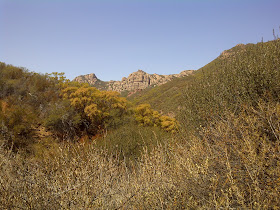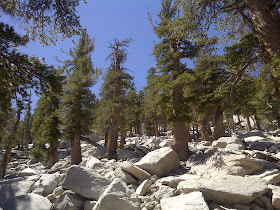“I have two doctors, my left leg and my right.” This quote by
British Historian G.M. Trevelyan sums up the primary reason I took up hiking.
You see, four years ago, I weighed 420 pounds. At more than
twice my normal weight, I was morbidly obese. My Body Mass Index or BMI – a
common measure used to determine medical risk due to obesity – was estimated at
56. To put this into perspective, according to the National Heart, Lung and
Blood Institute, 30 BMI is the low range of Class I obesity. At 56 BMI, I was
Class III.
I was considered pre-diabetic. I had circulatory and breathing problems.
Cellulitis – a bacterial skin infection common among the super obese – was
forming at my ankles and traveling up my legs. On top of this, I was suffering
from depression and felt hopeless to break a terrible addiction to sugary and
fatty foods.
But this story has a happy ending. And today, I would like to
tell you a bit of my own story of recovery, and share with you how, by putting
my two legs to work as my doctors, I may have quite literally saved my life.
After I lost my social services job to budget cuts in 2008, I
was unable to get private health insurance because I was considered too high of
a risk. I decided I needed to take immediate and drastic measures to improve my
conditions myself. If not, I feared wouldn’t live to celebrate my 40th
birthday.
My fears were not
unfounded. According to the National Institutes of Health, I was at a
substantial risk of developing a slew of deadly obesity-related diseases. Based
on all evidence, I needed to get control of my eating habits and begin getting
regular exercise if I wanted to stay alive.
Not knowing where to start, I did some basic research. I came
across a document called the 2008 Physical Activity Guidelines for Americans,
put forth by the U.S. Department of Health and Human Services. According to the
report, I found that aerobic activity is key for weight loss and the prevention
of weight gain.
In fact, aerobic activity also lowers risk of obesity-related
diseases such as coronary heart disease and stroke, high blood pressure, high
cholesterol and type 2 diabetes. It also treats metabolic syndrome and may help
prevent certain types of cancer. In short, engaging in regular aerobic activity
lowers your risk of early death.
That’s exactly what I was looking for! And the evidence is pretty
hard to ignore. Upon further research, I learned that walking is the primary
aerobic activity recommended by the National Heart, Lung and Blood Institute
for people struggling with obesity.
So what did I do? I started walking!
Let me tell you, it was work to start moving that super obese
body. And honestly, I found the work boring, tedious even. Fortunately, though,
I experienced an immediate drop in weight as I began eating right and getting
regular exercise. And this I did not
find boring at all.
So I stuck with the walking and, as my health improved, I began
seeking out longer and more difficult routes for my walks. Soon, and almost organically,
I discovered and fell in love with hiking.
While walking can be done anywhere, even on a treadmill, hiking
involves getting out into nature, climbing hills and experiencing views.
Hiking, to me, feels much less like exercise and more like adventure. Plus,
hiking is much more aerobically intense than mere walking. To put it plainly,
hiking is walking on steroids.
It turns out, in fact, that hiking is more than great aerobic
exercise; hiking has anaerobic and psycho-spiritual benefits as well.
As my research led me out onto the trails, I would find that
hiking brings muscles to the point of exhaustion and builds them up stronger. This
is anaerobic exercise, and anaerobic exercise makes the whole body stronger,
also improving bone density.
According to fitness promotion web site Livestrong.com, hiking
is an excellent workout for the muscles of your lower body and core. The
primary muscles worked include the quadriceps and hamstrings, the coordinating
muscles of your upper leg; your calves, which push blood from your lower
extremities back up to your heart; your glutes and hips; and your abs. If you
carry a pack, your shoulders will build muscle over time as well, as you
further strengthen your core.
An added benefit of building a strong core through hiking as an
anaerobic workout has been reduced pressure on my spine. The back pain that was
a consequence of carrying extra bulk is gone. I’m stronger than ever before,
and I feel like I got back 15 years of my life – I feel 26, not 41!
I mentioned earlier that hiking has psycho-spiritual benefits as
well. To me, this means even as hiking builds a stronger body it cleanses the
mind and refreshes the soul.
The US Department of Health and Human Services recognizes that
increased physical activity, such as hiking, reduces depression and leads to
better cognitive function. Hiking may even improve the quality of your sleep. It
may be as simple as the chemical reaction of endorphins being released into
your blood stream during physical exercise that causes a sense of wellbeing
while hiking. But it is also something outside the body, too, that sparks an
inner peace while out on the trail.
Finding yourself in nature heals the soul. Vistas clear the mind
and provide much-needed perspective when the stress of day-to-day living sets
in. And each component of nature – the smells, the sights and the sounds – calm
and soothe rattled nerves.
For transcendentalist Henry David Thoreau it was his beloved
lake Walden. He wrote: “A lake is the landscape's most beautiful and expressive
feature. It is Earth's eye; looking into which the beholder measures the depth
of his own nature.” For me, it is the summit of any hill or mountain. I tend to
tell people, perhaps less eloquently than Thoreau, that I hike for the payoff.
It is the views, and the feelings that come from pushing my body to new limits
in the cathedral of nature, that bring about small bursts of lasting moments of
rapture.
Imagine, feelings of rapture, and all you have to do is strap on
a sturdy pair of shoes, grab a bottle of water and some trail mix, and make
tracks to the nearest trail head. Regardless of your current fitness level, you
can find a trail nearby where you can immediately start receiving the benefits
of hiking.
So I challenge you. Sometime in the next week, get out there,
try for yourself and see if what I’m telling you is true. I promise that soon,
you too will credit your legs as your doctors as you hike for your life!
If you are interested in having me speak to your organization or at an event, leave a comment below. You may also follow me on Twitter @MyFitLife2Day, and check out my blog MyFitLife2Day, which charts my ongoing journey of overcoming super obesity. The video below is the above speech as delivered at a Toastmasters club in Southern California.

















